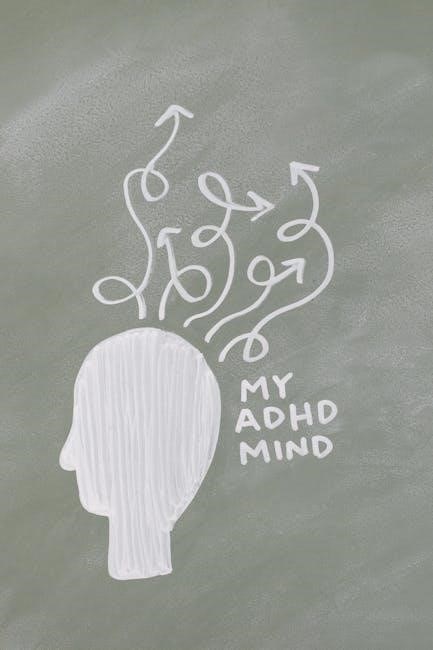Here’s the requested section:

Cognition: Exploring the Science of the Mind 8th Edition PDF
Cognition: Exploring the Science of the Mind‚ in its 8th edition‚ delves into how our minds process information. This edition provides new digital tools‚ for better learning. It covers foundational topics and integrates real-world examples‚ making it accessible.
Here’s the requested section:
Overview of the Textbook
The textbook‚ Cognition: Exploring the Science of the Mind‚ 8th Edition‚ offers a comprehensive introduction to the field of cognitive psychology. It examines how the mind acquires‚ stores‚ transforms‚ and uses information. This edition emphasizes an interactive and applied approach to make the concepts more accessible and engaging for students. Key features include updated research‚ real-world examples‚ and new digital tools designed to enhance learning.
The book is structured to provide a clear understanding of core cognitive processes‚ such as perception‚ attention‚ memory‚ language‚ problem-solving‚ decision-making‚ and reasoning. Each chapter integrates classic studies with contemporary findings‚ showcasing the evolution of cognitive science. Furthermore‚ the 8th edition includes features that promote active learning‚ such as retrieval practice exercises and interactive simulations. It aims to equip students with a solid foundation in cognitive psychology and its applications to everyday life. The author‚ Daniel Reisberg‚ presents the material in a way that encourages critical thinking and deeper engagement with the subject matter.
Here’s the requested section:
Key Topics Covered in the Book
Cognition: Exploring the Science of the Mind‚ 8th Edition‚ thoroughly covers several key areas within cognitive psychology. The book begins with an exploration of perception‚ examining how we interpret sensory information from the world around us. It moves into attention‚ discussing the selective nature of our awareness and its limitations. Memory is a central focus‚ with chapters dedicated to different types of memory‚ encoding‚ storage‚ and retrieval processes.
Language is another major topic‚ covering language acquisition‚ comprehension‚ and production. The book also delves into higher-level cognitive functions like problem-solving‚ where it examines strategies and obstacles in finding solutions. Decision-making processes are explored‚ including biases and heuristics that influence our choices. Finally‚ reasoning is addressed‚ focusing on both deductive and inductive reasoning and their roles in forming beliefs and drawing conclusions. Each topic is presented with relevant research‚ real-world applications‚ and interactive elements to enhance student understanding. This comprehensive coverage makes the textbook a valuable resource for students.
Here’s the requested section:
Perception
Perception‚ as explored in the 8th edition‚ is the initial cognitive process where sensory information is organized and interpreted. The book examines how we transform raw sensory data into meaningful experiences‚ relying on prior knowledge and expectations. Visual perception is a primary focus‚ detailing how we perceive depth‚ form‚ and motion. Auditory perception is also covered‚ explaining how we process sounds‚ recognize speech‚ and localize sound sources.
The textbook further discusses the influence of attention on perception‚ highlighting how selective attention filters sensory inputs. It addresses phenomena like change blindness and inattentional blindness‚ which demonstrate the limitations of our perceptual awareness. Moreover‚ the role of context and expectations in shaping perception is examined‚ illustrating how top-down processing can alter our interpretations of sensory information. The book also explores perceptual illusions‚ providing insights into the mechanisms underlying perceptual errors. By integrating classic research with contemporary findings‚ the book offers a comprehensive overview of how we construct our subjective reality through perception.
Here’s the requested section:
Attention
Attention‚ a key cognitive function‚ is thoroughly explored in the textbook‚ detailing how we selectively focus on specific aspects of our environment. The book elucidates different types of attention‚ including selective attention‚ divided attention‚ and sustained attention. Selective attention enables us to filter irrelevant information‚ as demonstrated by classic experiments like the dichotic listening task. Divided attention‚ on the other hand‚ refers to our ability to perform multiple tasks simultaneously‚ though often with reduced efficiency.
The text discusses the cognitive resources required for attention and how these resources are limited. It covers theories of attention‚ such as the early selection and late selection models‚ offering insights into when and how attention filters information. Furthermore‚ the book examines the neural mechanisms underlying attention‚ linking specific brain regions to attentional processes. Disorders of attention‚ like ADHD‚ are also addressed‚ providing a comprehensive understanding of the complexities of attentional control and its impact on daily life. The exploration of attention integrates empirical research with real-world applications‚ highlighting its importance in various cognitive tasks.
Here’s the requested section:
Memory
Memory‚ a cornerstone of cognitive psychology‚ receives extensive coverage‚ with detailed explanations of memory systems. The textbook differentiates between sensory memory‚ short-term memory‚ and long-term memory‚ emphasizing their distinct roles in encoding‚ storing‚ and retrieving information. Sensory memory briefly holds sensory information‚ while short-term memory maintains information for a limited duration. Long-term memory‚ conversely‚ stores information for extended periods.
The book explores the processes involved in transferring information from short-term to long-term memory‚ including encoding strategies like elaborative rehearsal. It explains the different types of long-term memory‚ such as episodic memory (personal experiences) and semantic memory (general knowledge). Memory retrieval processes are also examined‚ focusing on factors that influence recall and recognition. The text addresses memory distortions and errors‚ including false memories and the misinformation effect. Neurological aspects of memory‚ linking brain structures to memory functions‚ are discussed. Additionally‚ the book delves into memory impairments‚ such as amnesia‚ providing a thorough understanding of memory’s complexities.
Here’s the requested section:

Language
The textbook dedicates a section to language‚ a fundamental aspect of human cognition. This section explores the structure of language‚ from phonemes (basic units of sound) to morphemes (smallest units of meaning) and syntax (rules governing sentence construction). It elucidates how these elements combine to form meaningful communication. The book covers language acquisition‚ examining the stages of language development in children and the cognitive processes involved. Theories of language acquisition‚ such as nativist and empiricist perspectives‚ are discussed‚ providing a comprehensive overview of how humans learn language.
The section also explores language comprehension‚ focusing on how individuals process and understand spoken and written language. Factors influencing comprehension‚ such as context and prior knowledge‚ are examined. Language production‚ including the processes involved in planning and producing speech‚ is analyzed. The text delves into the relationship between language and thought‚ exploring the Sapir-Whorf hypothesis and its implications for how language shapes our perception of the world. Neurobiological aspects of language‚ linking brain areas to language functions‚ are also covered. The impact of language on cognitive processes like memory and problem-solving is discussed‚ highlighting language’s central role in cognition.
Here’s the requested section:
Problem-Solving
The “Problem-Solving” section comprehensively explores the cognitive processes involved in overcoming obstacles and achieving goals. It begins by defining problem-solving and outlining different types of problems‚ such as well-defined and ill-defined problems. The text discusses various strategies used in problem-solving‚ including algorithms‚ heuristics‚ and insight. Algorithms‚ which are step-by-step procedures guaranteeing a solution‚ are contrasted with heuristics‚ which are mental shortcuts that may or may not lead to a solution.
The role of representation in problem-solving is emphasized‚ highlighting how the way a problem is framed can significantly impact its difficulty. Common obstacles to problem-solving‚ like functional fixedness and mental sets‚ are examined. Functional fixedness refers to the tendency to see objects as having only their typical use‚ hindering creative solutions. Mental sets involve approaching problems with pre-existing strategies that may not be effective in all situations. The section also explores the influence of expertise on problem-solving‚ examining how experts differ from novices in their approach to problems. The cognitive processes underlying creative problem-solving are discussed‚ including incubation and insight.
Here’s the requested section:
Decision-Making
The “Decision-Making” section provides a detailed examination of the cognitive processes involved in making choices. It begins by outlining different models of decision-making‚ including rational choice theory and behavioral decision theory. Rational choice theory assumes that individuals make decisions by weighing the costs and benefits of each option and selecting the one that maximizes their utility.
Behavioral decision theory‚ on the other hand‚ acknowledges that human decision-making is often influenced by cognitive biases and heuristics. Common biases‚ such as the availability heuristic‚ representativeness heuristic‚ and anchoring bias‚ are explored. The availability heuristic leads individuals to overestimate the likelihood of events that are easily recalled‚ while the representativeness heuristic involves judging the probability of an event based on how similar it is to a prototype.
The section delves into the impact of emotions on decision-making‚ discussing how emotions can both facilitate and impair rational choices. The role of framing effects‚ where the way information is presented influences decisions‚ is also examined. Furthermore‚ the text explores the neural basis of decision-making‚ highlighting the brain regions involved in evaluating options and making choices.
Here’s the requested section:

Reasoning
The “Reasoning” section investigates the cognitive processes involved in drawing inferences and conclusions from information. It begins by distinguishing between deductive and inductive reasoning. Deductive reasoning involves drawing specific conclusions from general principles‚ while inductive reasoning involves forming general conclusions from specific observations. The text explores different types of deductive reasoning‚ such as syllogistic reasoning and conditional reasoning.
Syllogistic reasoning involves evaluating the validity of conclusions based on premises‚ while conditional reasoning involves drawing inferences based on “if-then” statements. The section delves into the cognitive biases that can impair deductive reasoning‚ such as the belief bias and the confirmation bias. The belief bias leads individuals to accept conclusions that are consistent with their beliefs‚ while the confirmation bias leads individuals to seek out information that confirms their existing beliefs.
The section examines the role of mental models in reasoning‚ discussing how individuals construct mental representations of situations to draw inferences. It explores different types of inductive reasoning‚ such as analogical reasoning and causal reasoning. Analogical reasoning involves drawing inferences based on similarities between situations‚ while causal reasoning involves identifying cause-and-effect relationships.
Here’s the requested section:
How to Find the PDF Version Online
Finding a PDF version online often starts with a targeted search. Use specific keywords like “Cognition Exploring the Science of the Mind 8th Edition PDF” in search engines. Include “free download” or “ebook” to refine the results. Be cautious of websites offering free downloads‚ as some may be illegal or contain malware.
Explore online forums and communities dedicated to textbooks. Reddit’s r/textbook‚ for instance‚ can be a valuable resource where users share links. Check digital archives and online libraries like Library Genesis (LibGen) or Z-Library‚ which sometimes host textbook PDFs. Always prioritize legal and ethical methods.
Many sites will offer the book for immediate download. Some websites may require registration or subscription to access the PDF. Verify the legitimacy of the source and scan downloaded files for viruses. Consider renting or purchasing the e-book legally to ensure you have a safe and authorized copy‚ especially for study purposes.

Here’s the requested section:
Availability of Digital Tools and Resources
The 8th edition enhances learning with digital tools and resources. Interactive platforms offer retrieval practice and active learning modules. These tools often include quizzes‚ flashcards‚ and simulations to reinforce understanding of key concepts. Digital resources may also feature multimedia content‚ such as videos and animations‚ to illustrate complex cognitive processes.
Some editions provide access to online study guides and supplementary materials. These resources often include chapter summaries‚ practice questions‚ and case studies. E-books offer features like highlighting‚ note-taking‚ and search functionality‚ which enhance engagement. Check the publisher’s website for access codes or registration instructions to unlock these resources.
Furthermore‚ some platforms provide adaptive learning tools. These tools tailor the learning experience to individual needs‚ providing personalized feedback and recommendations. Digital resources foster a more interactive and effective approach to studying cognition. The integration of technology aims to make learning more engaging and accessible.

Leave a Reply